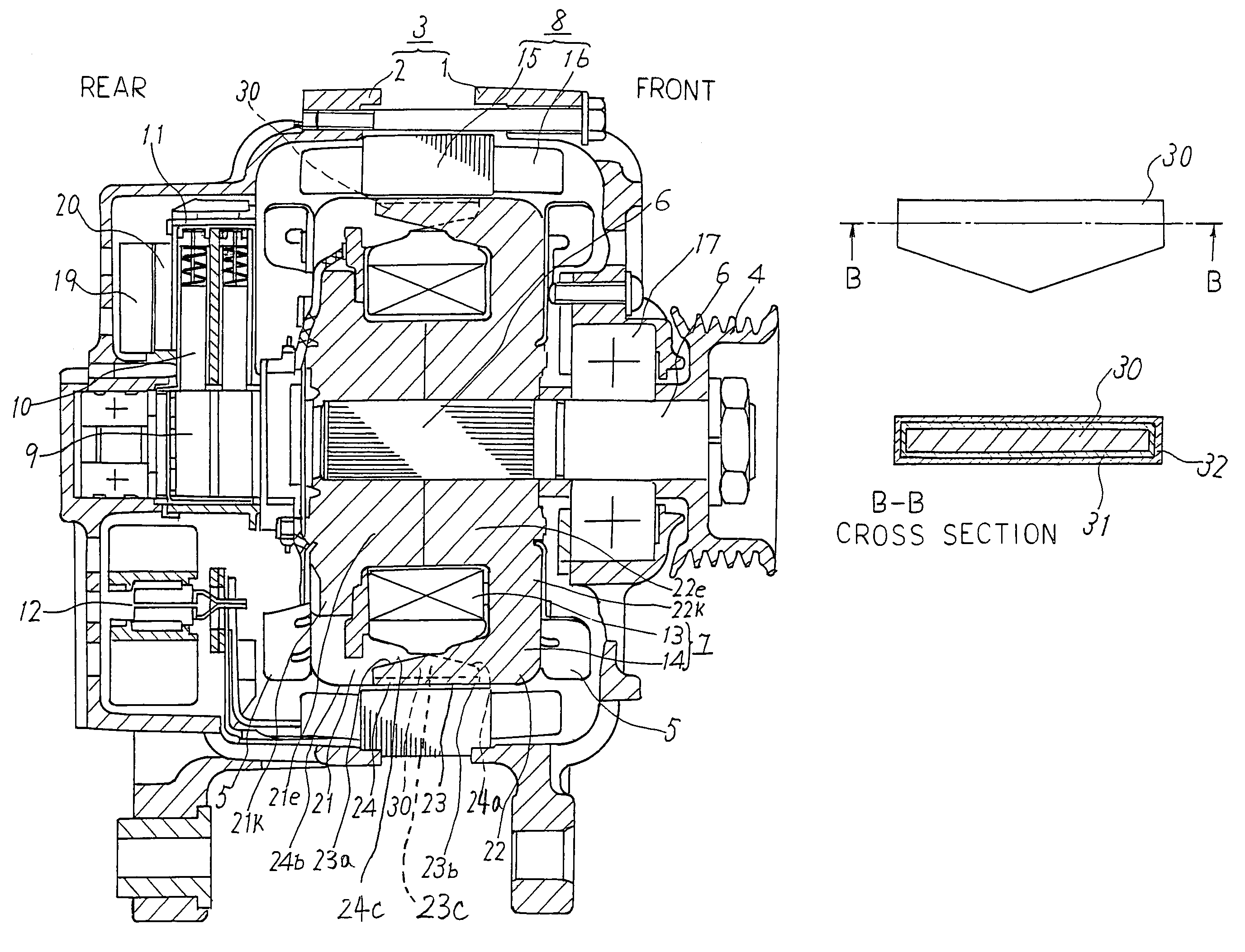Electric rotating machine
a rotating machine and electric technology, applied in the direction of magnetic circuit rotating parts, magnetic circuit shape/form/construction, magnetic bodies, etc., can solve the problems of reversible or irreversible demagnetization, deterioration of characteristics, cooling efficiency, etc., to prevent permanent deterioration of characteristics and improve the characteristics
- Summary
- Abstract
- Description
- Claims
- Application Information
AI Technical Summary
Benefits of technology
Problems solved by technology
Method used
Image
Examples
embodiment 1
[0024]An electric rotating machine according to Embodiment 1 of the present invention is hereinafter described with reference to FIGS. 1 to 3.
[0025]FIG. 1 is a perspective view showing a rotor incorporated and used in an electric rotating machine. As shown in FIG. 1, this rotor includes: a pole core comprised of a first pole core 21 and a second pole core 22 respectively having claw-shaped magnetic poles 23, 24 protruding like an alternate engagement with each other; and a permanent magnet 30 disposed between the claw-shaped magnetic poles 23, 24 on both sides thereof. The permanent magnet 30 acts to reduce leakage of magnetic flux between the claw-shaped magnetic poles 23, 24 adjacent to each other. The pole core is formed covering with a rotor coil as described later. The rotor is comprised of the pole core and a rotor winding described later.
[0026]FIGS. 2(a) and (b) are a side view and a sectional view of the permanent magnet 30 according to Embodiment 1 of the invention. FIG. 2(...
embodiment 2
[0041]An example of coating the permanent magnet 30 forming the rotor is coated with a single coating layer 31 is shown in the foregoing Embodiment 1. Now, as shown in a side view of FIG. 4 (a) and a sectional view of FIG. 4(b) taken along the line B—B of FIG., 4(a), an example of coating with the anticorrosive material forming a multi-layer structure (two-layer structure in the example of FIG. 4) is described in this Embodiment 2.
[0042]The multi-layer structure is formed by nickel plating and zinciferous inorganic material coating, and the nickel plating forms either a nickel plating layer (lower layer) 31 or a coating layer (upper layer) 32. Otherwise, the multi-layer structure is formed by aluminum plating and zinc plating, and the aluminum plating forms either an aluminum plating layer (lower layer) 31 or a coating layer (upper layer) 32. In other words, a two-layer structure is established irrespective of coating order of the nickel plating layer and zinciferous inorganic mater...
embodiment 3
[0047]An example of disposing each one permanent magnet 30 between the claw-shaped magnetic poles 23, 24 is shown in the foregoing Embodiment 1 and Embodiment 2. Now in this Embodiment 3, an example of disposing two permanent magnets 30a respectively on two sides of one claw-shaped magnetic pole 23 (24) (in other words, two permanent magnets 30a between the claw-shaped magnetic poles 23, 24) is described. As shown in FIG. 5(a) being a perspective view of an essential part of the rotor, FIG. 5(b) being an exploded view of the essential part and FIG. 5(c) being a developed view of a holding member for holding the permanent magnets 30a, the permanent magnets 30a are disposed on each side of each claw-shaped magnetic pole 23, 24, and the permanent magnets 30a are held on the claw-shaped magnetic pole 23 (24) by means of a metallic holding member 40.
[0048]As shown in FIGS. 5(a), (b) and (c), the holding member 30 holds the two permanent magnets 30a disposed on both sides of the claw-shap...
PUM
| Property | Measurement | Unit |
|---|---|---|
| thickness | aaaaa | aaaaa |
| electrical angle | aaaaa | aaaaa |
| magnetic flux | aaaaa | aaaaa |
Abstract
Description
Claims
Application Information
 Login to View More
Login to View More - R&D
- Intellectual Property
- Life Sciences
- Materials
- Tech Scout
- Unparalleled Data Quality
- Higher Quality Content
- 60% Fewer Hallucinations
Browse by: Latest US Patents, China's latest patents, Technical Efficacy Thesaurus, Application Domain, Technology Topic, Popular Technical Reports.
© 2025 PatSnap. All rights reserved.Legal|Privacy policy|Modern Slavery Act Transparency Statement|Sitemap|About US| Contact US: help@patsnap.com



